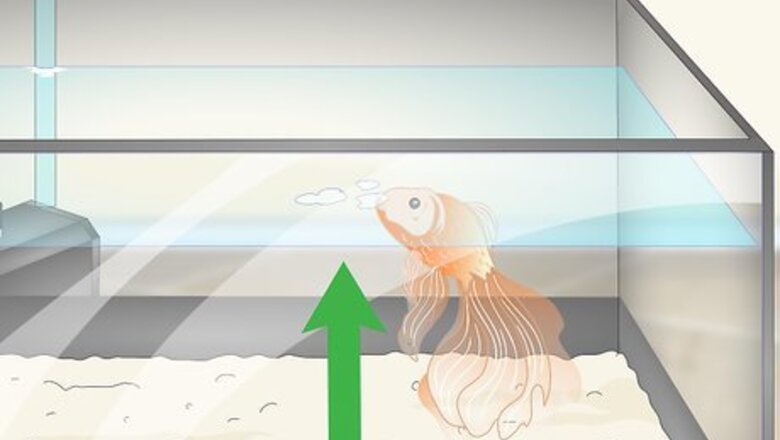
views
Looking for Symptoms of a Dying Fish
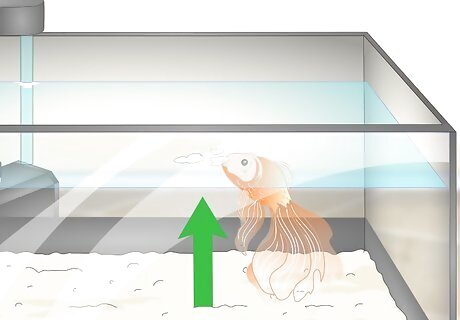
Check if your goldfish stays close to the surface. If your goldfish spends a lot of time just below the water’s surface or seems to be gasping at any air bubbles, it may be a sign that your fish is having a difficult time breathing. This might be due to low levels of oxygen in the water, high levels of stress, or something else entirely. If your goldfish is swimming around with their mouth open, it may be another sign that they are having difficulties getting enough oxygen.
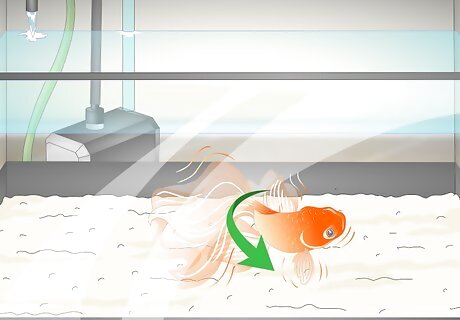
Watch your fish for unusual swimming patterns. Observe your fish for a few minutes at a time to see if they are swimming at an angle, upside down, or anything else that seems unusual. Goldfish will normally swim around in an upright position and stay nearer the bottom of the tank, so anything significantly different might be a sign that your goldfish is unwell. Similarly, make sure your goldfish is swimming around and interacting with things in the tank. If your goldfish is hardly moving and staying right at the bottom of the tank, it’s a sign that something may be seriously wrong with them.
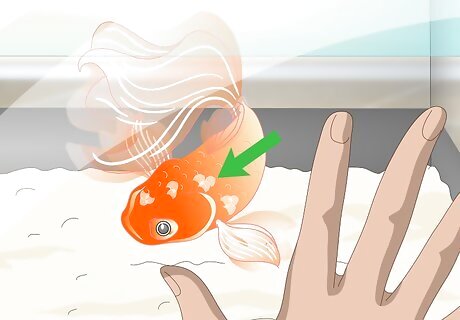
Take a close look at your goldfish's fins and scale. If you watch your fish often, you should have a rough idea of what they should look like. Watch your fish as they swim around, and see if you can get a close look at their scales and fins. Here are a few things to look out for: Look at your goldfish’s fins for any tearing or red veins that are bulging out. This is normally a sign of stress or could be an indicator that there is another fish in the tank that is bullying them. Make sure the fins are at their full length and not starting to shrink or deteriorate into a stump. If any part of your fish’s fins seems to be disappearing, it could a sign of fin rot. Black spots might mean that your goldfish has ammonia burn or some type of parasite. Make sure your fish isn’t bleeding or missing any scales. If you notice any small red marks on your fish or any spots in its skin without scales, something is hurting your fish. It could be another, more aggressive fish in the same tank, or it may be your fish rubbing against something to try and scratch a parasite.
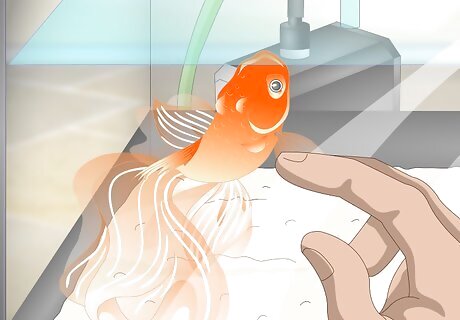
Check if there's anything on your fish that wasn't there before. As your goldfish is swimming around, examine them for any new spots, bumps or textures on their skin and face. These could all be signs of parasites, bacterial infections, or other serious illnesses. Here are a few things you should keep an eye out for: Look for a fine white fuzz, particularly around the mouth, or any other discoloration of the scales. This could be a sign of a bacterial infection that will need to be treated. See if you notice any small, white or black spots on your fish. White spots may indicate that your fish has ich, which is a common parasite found in goldfish. Check for bloated or raised scales. If you see any bloating or protuberance where you’ve not seen one before, it could mean that your goldfish is ill. However, it may also mean that they’re pregnant, or that you’ve just been overfeeding them.
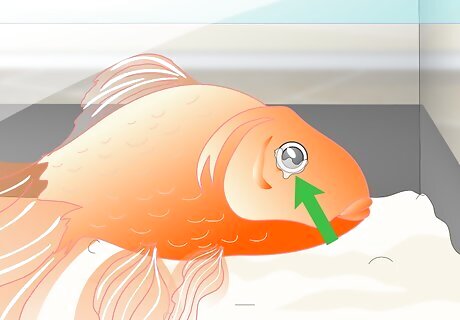
Pay close attention to your fish’s eyes. It can be very hard to get a good look at your fish’s eyes, but you should be able to inspect them with a bit of time. Look through the tank until your fish comes close enough to see their eyes. Unnatural bulging, a build-up of mucous or cloudy-looking eyes can all be signs that something is wrong. Protruding eyes may be a sign of “pop eye”, which is usually caused by an infection. Cloudy eyes, or eyes with a cloudy film over them, can be a sign of some sort of vitamin deficiency.
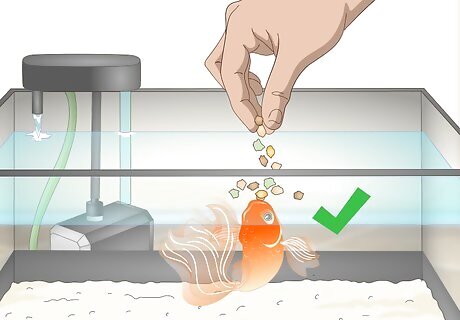
Make sure your goldfish is eating. When you next feed your goldfish, keep an eye out to make sure all of them are swimming to try and get some food. Goldfish will eat anything they can, so goldfish that aren’t eating are likely very ill. If you notice that your fish isn’t eating, try sprinkling a little food so that it falls right in front of them. It may be that they can’t see the food or are slow to react to it, this is another sign that something is wrong.
Caring for a Sick or Dying Goldfish
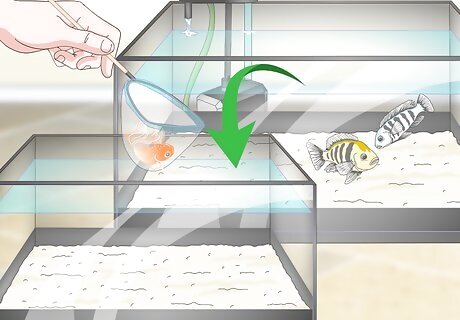
Separate your goldfish from any others in the same tank. If you notice your fish is unwell, you should immediately shift it to a smaller, “hospital” tank. Fill a small tank or bowl with new filtered or mineral water, and transfer your unwell fish into this tank. Keep an eye on it for a few hours to see if your fish looks better. If you have more than one fish in a tank, you should immediately quarantine the unwell goldfish in a hospital tank. If your goldfish is suffering from an infection or parasite, keeping it in the same tank may let the illness spread. Sometimes a change of water is all your fish needs to start getting better.
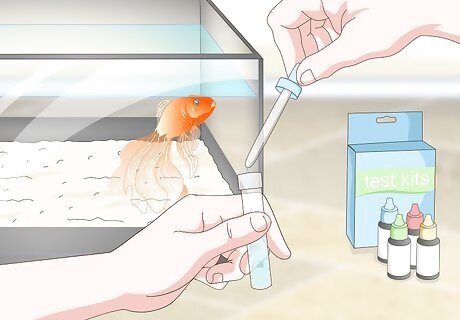
Use a freshwater test kit to test the water in your tank. A freshwater master test kit will let you test for anything in the water that might be making your fish sick, and should be available from your local pet store. Follow the instructions on your test kit to check the levels of ammonia, nitrates, and oxygen in your water. There will be different solutions depending on the issues with your water: If you have high levels of ammonia or nitrates in your water, you should clean it out and replace it with new water immediately. Keep an eye on the ammonia levels in your water to make sure they stay at a reasonable level. If your filter pump is having difficulty keeping up, try cleaning it thoroughly, or replacing ¼ of the water every day to help it out. If there’s not enough oxygen in the water, you may need to replace or repair your air pump to make sure your fish can breathe properly. If you don’t want to buy a freshwater test kit, you may be able to take a small vial of water to your local pet store and get them to test it instead.
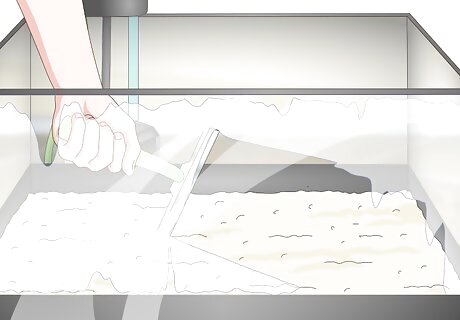
Clean your fish tank. Take any remaining fish out of the water and keep them somewhere safe. Use an algae pad to clean the sides of tank, and siphon out the water left inside. Clean the gravel at the bottom of the tank with a gravel vacuum, and make sure any decorations are clean as well. There may be rotting food or other damaging things in the gravel at the base of your fish tank, so make sure it is cleaned completely.
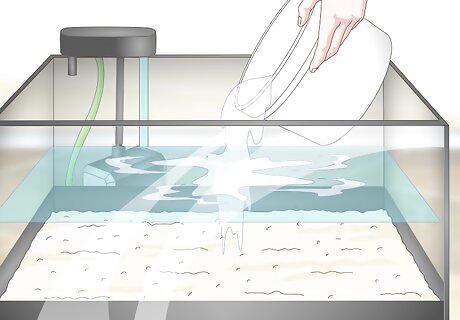
Refill your tank with clean, treated water. Once the tank is empty and clean, you should refill it with treated aquarium water at the temperature your fish need. Mineral and spring water will be clean and free from anything that may harm your fish. Refill your fish tank and use a thermometer to make sure it is at the right temperature. You can use tap water to refill your tank, but make sure it has been properly treated with a water conditioner before using it. It may pay to test conditioned tap water to make sure it will be OK for your fish. If the water in your tank is too warm, add some chilled water to lower the temperature to one that will suit your goldfish. Goldfish will normally thrive in water around 23 °C (73 °F).
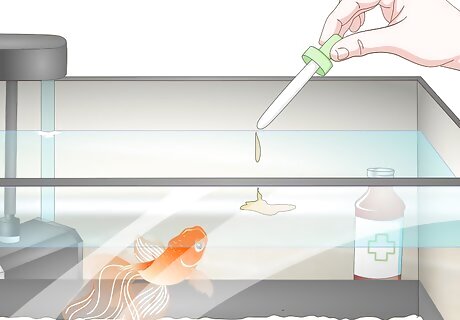
Start medicating your fish if it still looks sick. Return the fish to the now clean tank and keep an eye on it. If it still doesn’t seem to be getting better, you may need to start medicating your fish. Purchase the right medication for the disease you think your goldfish has from your local pet store, and follow the instructions provided to begin treating your fish. Here are a few common diseases and the appropriate medication: Ich is a parasite that may infect your fish, which will look like small white grains of salt on its scales. You can treat ich with aquarium salt, or formalin treatment which is used as an ich treatment and available from your local pet store. Fin rot and swim bladder are both fungal infections and can be treated with a fungus eliminator. If your goldfish has a parasite, you can treat it with a parasite guard, which should be available at your local pet store or online.
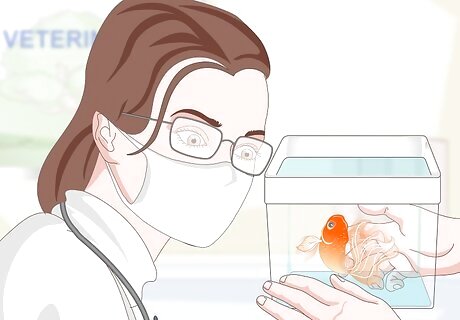
Take your goldfish to the vet if they are still unwell. If you are unsure how to treat your goldfish, or if they don’t seem to be getting better, you should look into taking them to a vet. Call your local veterinarian’s clinic to see if they will be able to help treat your fish and to make an appointment. You will likely need to transfer your fish to a plastic bag of water or a smaller bowl to transport them. Cover the bag or bowl with a paper bag or something similar so that the fish doesn’t get stressed while being carried.
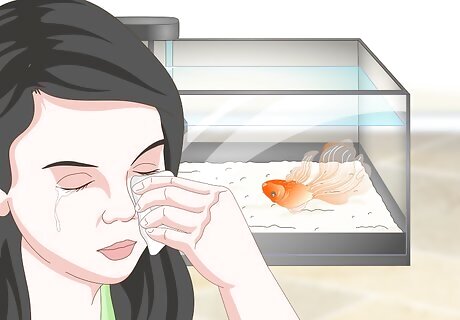
Be prepared to say goodbye to your goldfish. While your vet will do everything they can to keep your goldfish alive, sometimes there is nothing that can be done. If you can’t cure your goldfish, try and spend more time with them as you come to terms with the fact that they may pass away. Take comfort in knowing that you did everything you could to try and save your goldfish and that you took care of them as well as you could. Consider getting a new goldfish when you are ready.



















Comments
0 comment